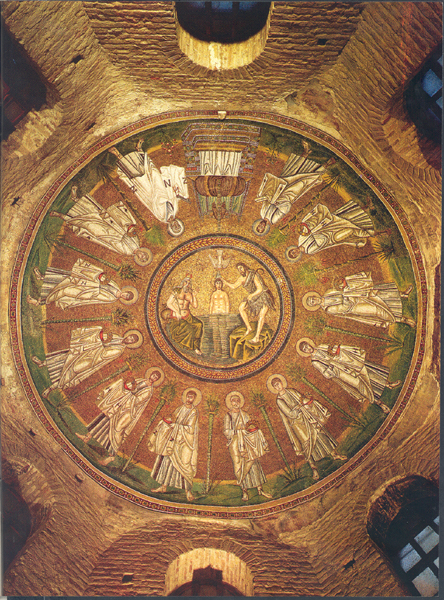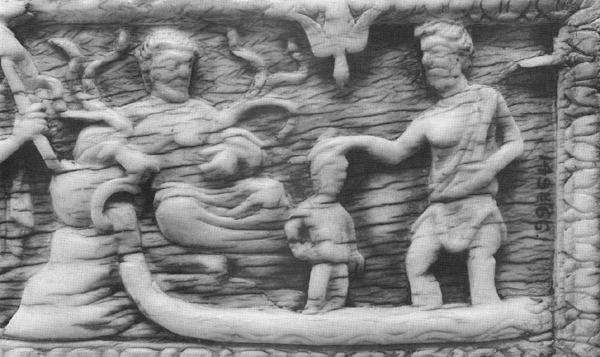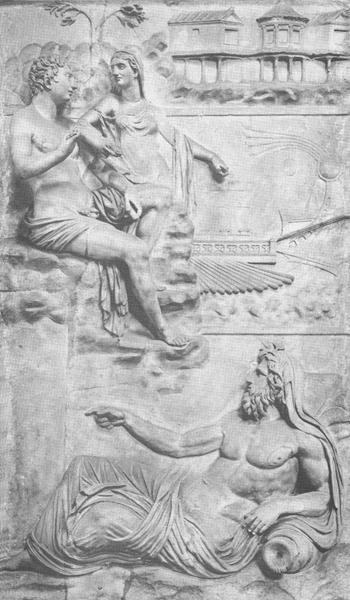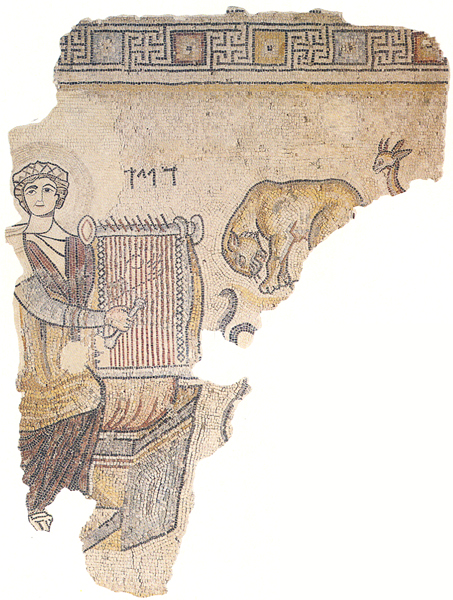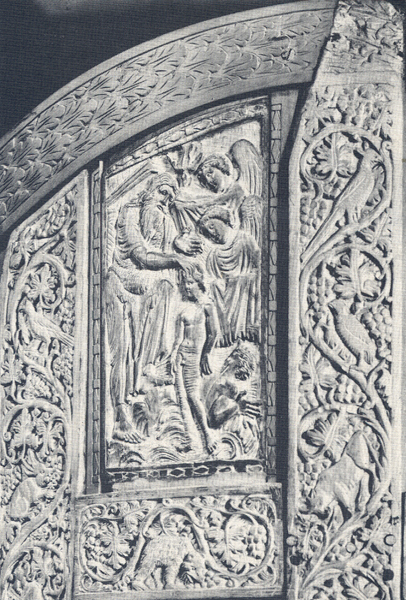What Are Pagan River Gods Doing in Scenes of Jesus’ Baptism?
Footnotes
See Dale C. Allison, Jr., “The Baptism of Jesus and a New Dead Sea Scroll,” BAR 18:02.
Endnotes
The personification of rivers is particularly common on triumphal arches. In addition to the Arch of Constantine (see Bernard Andreae, Art of Rome [New York: H.N. Abrams, 1977], fig. 8), see the Arch Septimius Severus, published by Hans Peter L’Orange and Armin von Gerken, Der späntike Bildesmuch des konstantinsbogens (Berlin: de Gruyter, 1939), fig. 25. The relief panel of Paris and Oenone, from the Palazzo Spada, was published in Richard Brilliant, Visual Narratives (Ithaca, NY: Cornell Univ. Press, 1984), pl. 2.3.
A well-known example is the appearance of Tiberinus to Aeneus while he slept on the riverbank (Virgil, Aeneid 8.40–90). See Carina Weiss, “Fluvii,” in Lexikon Ikonographicum mythologiae classicae, ed. Hans Christoph Ackerman and Jean-Robert Gisler (Zurich: Artemis, 1981–), vol. 4.1, pp. 139–148, plates in vol. 4.2, pp. 70–73; J. Toutain,“Les cultes des fleuves, sa forme primitive et ses principaux rites, chez les peuples de l’antiquite classique,” L’ethnographie, new series 13/14 (1926), pp. 1–7; Maximilian Lehnerdt, “Flussgötter,” in Roscher Lex. 1.2, pp. 1487–1496; Erika Dinkler-von Schubert, “Fluss II (ikonographisch),” in Das Reallexikon für Antika und Christentum, ed. Theodor Klauser in association with Franz Joseph Dolger, Hans Leitzmann and Leopold Wenger (Stuttgart: Hiersemann, 1950-), vol. 8 (1972), pp. 73–100; Otto Waser, “Flussgötter,” in Realencyklopadie für protestantische Theologie und Kirche, ed. J.J. Herzog (Leipzig: J.C. Heinrichs, 1909), vol. 6, pp. 2774–2815; Frederich Matz, Naturpersonifikation der griechische Kunst, dissertation, Göttingen, 1913; and Henri Leclercq, “Fleuves,” in Dictionnaire d’archéologie chrétienne et de liturgie, ed. Leclercq (Paris, 1923), vol. 5.2, cols. 1760–1761
For other examples, see Marion Lawrence, “Three Pagan Themes in Christian Art,” in De Artibus Opuscula: XL: Essays in Honor of Erwin Panofsky (New York: New York Univ. Press, 1961), pp. 323–334.
See Bede, de Locis Sanctis 12, text in Johannes Migne Patrologia Latina (PL) 94, cols. 1179–1190. The crosstmarker is illustrated in manuscript illuminations, icons, and mosaics from at least the tenth century on.
According to Eusebius (De vita Constantini 4.62, trans. in Nicene and Post-Nicene Fathers [NPNF], series 2, vol. 1, p. 556; Greek text in Migne, Patrologia graeca [PG], vol. 20, col. 1216), Constantine had wished to be baptized in the Jordan. For descriptions of the Jordan by early pilgrims, see Egeria’s account (c. 400), Peregrinatio Aetheriae 12.4 and 15.1–6, and The Pilgrim of Bordeaux 598 (both trans. by J. Wilkinson, Egeria’s Travels to the Holy Land [Warminster, Eng.: Aris and Philips, 1981]).
Most ampullae are thought to have carried oil from the lamps burning at these sites and not Jordan water as is the custom today. For examples, see André Grabar, Ampoules de terre sainte (Monza, Bobbio) (Paris: Klincksieck, 1958), Bobbio: #18, pp. 40–41; #19, pp. 41–2; Monza: #2, pp. 18–19 (with a personification of the Jordan). Also see Lieselotte Kotszche-Breitenbruch, “Gebun,” in Klauser, Reallexikon, vol. 9 (1973), col. 209; Josef Engemann, “Palästinische Pilgerampullen im F. J. Dolger Institute in Bonn,” Jahrbuch für Antike und Christentum, vol. 16 (1973), pp. 5–27; and Archer St. Clair, author of catalogue entry #527 in The Age of Spirituality: Catalogue of the Exhibition at the Metropolitan Museum of Art, ed. Kurt Weitzmann (New York: Metropolitan Museum of Art, 1979), p. 588.
Gregory of Nyssa, In Diem Luminum, trans. William Moore, NPNF, ser. 2, vol. 5, p. 522; Greek text, ed. Werner Jaeger, Gregorii Nysseni Opera (Leiden: Brill, 1967), part 1, vol. 9, pp. 232–233.
Origen, Commentarius in Johannes 6.238–239, trans. Ronald E. Heine, Origen Commentary on the Gospel according to John Books 1–10, Fathers of Church Series (FOC) 80 (Washington: Catholic Univ. of America Press, 1989), p. 233; and Cyril of Jerusalem, Catacheses 3.5, trans. Leo P. McCauley, The Works of Saint Cyril of Jerusalem, FOC 64 (Washington: Catholic Univ. of America Press, 1969), vol. 1, p. 111. This passage is particularly cited by Justin Martyr, Dialogue with Trypho 86.6, trans. Thomas B. Falls, Writings of Saint justin Martyr, FOC 9 (New York: Christian Heritage, 1948), pp. 285–286; Greek text in Johannes C. T. Otto (1841), pp. 311–315; Irenaeus, Adversus Haereses 5.16.4, trans. A Cleveland Coxe, in The Ante-Nicene Fathers (ANF) vol. 1, p. 545; Greek text in Migne, PG, vol. 7, cols. 1170–1172; and Tertullian, Adversus Judaeos 13, trans., S. Thelwall, ANF; vol. 3, pp. 170–171; text in Corpus scriptorum ecclesiasticorum latinorum (CSEL) 70 (1942), pp. 251–331.
For Joshua parallels, see Cyril of Jerusalem, Catacheses 10.11, trans. McCauley, The Works of Saint Cyril, pp. 202–203; Greek text in Migne, PG, vol. 33, col. 676D–677A; and Gregory of Nyssa, In Diem Luminum, in NPNF, ser. 2, vol. 5, pp. 520–521; Greek text, Jagar, Gregorii, pp. 232–235;.
This is symbolized in the liturgy by the catechumens entering the baptistry. See the long and detailed discussions by Franz Josef Dolger, “Der Durchzug durch den Jordan als Sinnbild der christlichen Taufe,” AC 2, 70f; Per Lundberg, La typologie baptismale (Leipzig: A. Lorentz, 1942), pp. 146–166; and Jean Danielou, The Bible and the Liturgy (Notre Dame, IN: Univ. of Notre Dame Press, 1956), pp. 99–113.
Jerome, Homily 89, trans. Marie L. Ewald, The Homilies of Saint Jerome, FOC 57 (Washington: Catholic Univ. of America Press, 1963), vol. 2, p. 230. There was also a tradition that the Jordan waters miraculously fled back and then rose in a heap as an annual display for visiting pilgrims.
See Ambrose, de Sacramentiis 1.18, trans. Roy J. Deferrari, Saint Ambrose: Theological and Dogmatic Works, FOC 44 (Washington: Catholiv Univ. of America Press, 1963), p. 275, text in CSEL 73, p. 23; and Ignatius, Epistle to the Ephesians 18.2, trans. Kirsopp Lake, The Apostolic Fathers, Loeb Classical Library (Cambridge, MA: Harvard Univ. Press, 1912), vol. 1, pp. 191–193.
It is interesting to note that the Jordan is actually formed from the waters of four smaller streams (compare the four rivers of paradise), which converge in the plain of Lake Huleh, and eventually ends in the Dead Sea. See Nelson Glueck, The River jordan (New York: McGraw-Hill, 1968), for a survey of this river’s history and importance to the life and geography of Palestine and Israel.
The sixth- or seventh-century fresco of Jesus’ baptism from the monastery in Bawait shows the river deity as feminine, perhaps because rivers were often personified by female spirits in the older traditions of Greek art. This image was published by J. Cledat, La monastere et la necropole de Baouit (Cairo, 1916). Also see articles by Waser, “Vom Flubgotte Jordan und andern Personifikation,” in Festgabe A. Kaeagi (Frauenfeld, 1919), pp. 191–217, and G. Ristow, “Zur Personifikation des Jordan in Taufdarstellungen der fruhen christliche Kunst,” Arbeit der DDR 2 (1957), pp. 120–126.
See Ambrose, de Sacramentiis 1.18; Martyr, Dialogue with Trypho 76.4–6; and Ignatius, Epistle to the Ephesians 18.2.
Ambrose, for example, refers to the font as “Jordan,” Interpretation of Psalm 61, text in Migne, PL, vol. 14, col. 1180; also see Cyril of Jerusalem, Mystogogical Catechesis 3.1


